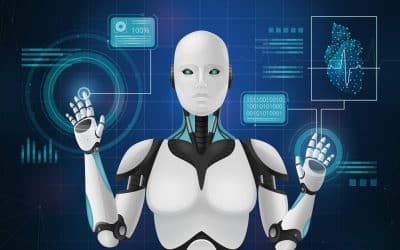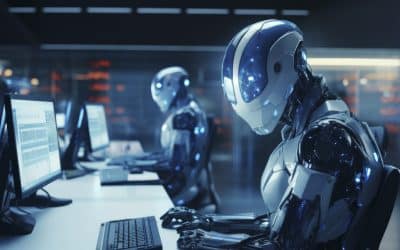One of the most significant aspects of this new revolution is how computing tools and methods have become more accessible. Data scientists have created advanced data-crunching devices in the past five years by efficiently implementing sophisticated ML Techniques. The results are astounding. Various machine-learning algorithms were developed to solve complicated real-world issues during this dynamic time. Machine learning algorithms are automatic and self-learning, improving as time passes.
The core of machine learning is algorithms, which are refined to create models that are used to drive many of the most potent technological innovations that are currently happening. In this piece, you’ll learn about seven important ML algorithms you should know and the many different learning methods used to transform ML methods into ML models.
What Is Machine Learning?
Simply put, it is an area of artificial intelligence in which computers offer predictions upon patterns discovered directly from data without being explicitly programmed. This definition clearly shows that it is one of the subfields of artificial intelligence.
Machine learning extracts valuable information from massive amounts of data using algorithms that detect patterns and then learn through an ongoing process. ML algorithms use computation methods to learn directly from data rather than being dependent on a predetermined formula that could serve as a template.
The effectiveness of ML algorithms improves adaptively by increasing the quantity of data available throughout the “learning” process. In particular, deep learning is a specific sub-discipline of machine learning that helps computers mimic human behavior, such as studying from various examples. Deep learning has better performance metrics than traditional ML algorithms.
Although machine learning isn’t an entirely new idea—it dates back to World War II, when the Enigma Machine was used. Applying sophisticated algorithms automatically to increasing amounts and kinds of data is a reasonably modern technology.
Different Types Of Machine Learning
We’ve now given you an overview of machine learning and how it is incorporated into the other buzzwords you might encounter within this field. Let’s closely review the various kinds that machine-learning algorithms employ. Machine learning algorithms are generally divided into unsupervised, supervised, reinforcement, and self-supervised learning. Learn about the different types of algorithms in more detail and the most popular use scenarios.
Supervised Machine Learning
Machine learning involves algorithms learning patterns from data collected over time before applying them to the latest information in the form of forecasts. This is sometimes called supervised learning. The supervised learning algorithms are displayed as outputs from historical inputs for a specific problem that the ML Development Company is trying to resolve. The inputs are aspects or dimensions of the phenomenon we’re attempting to forecast, and the outputs represent those we hope to forecast. Our example of spam detection illustrates this.
A supervised learning algorithm can be trained using spam email data to detect spam. The data sources would include aspects or dimensions of the emails, like the subject line, whether it had links with a suspicious appearance or other data that may provide clues to determine if an email was spammy.
The result would tell us the actual outcome: whether the email was considered spam. In learning the model, the algorithm defines the statistical relationships between the input variables (the various dimensions of spam emails) and the output variables (whether the email was legitimate or not). Functional mapping can then determine the outcome of previously unknown information.
There are two main types of use cases for supervised learning:
Regression
Regression can be used to forecast a consistent event that occurs within a specific range. One example is home price predictions based on the area of the property. In this area, it is located, the number of bedrooms, as well as additional dimensions relevant to the house.
Classification
Classification can be used to determine if an event can be classified into two or several categories. Spam detectors are classified models (either spam or not); however, other applications of classification are predictions of customer churn (will it be churning or not) and recognition of cars in photographs (multiple types).
Unsupervised Machine Learning
Instead of developing patterns to translate inputs into outputs, Unsupervised learning algorithms find common patterns in data without having to be explicitly presented with results. These algorithms can typically cluster and group various entities and objects. One of the most compelling examples of unsupervised learning is the segmentation of customers.
Businesses usually have multiple types of personas for their customers, which they cater to. Companies often need information-based methods of understanding their target customers to serve them better, and unsupervised learning is the next step.
In this case, the algorithm could learn to identify the best way to group customers based on different attributes, such as how often they use a particular product, their age, and how they interact with the products. Using the same parameters, this algorithm could predict the most likely group of new customers.
Unsupervised algorithms can also decrease the size of a data set (i.e., the number of components) by reducing dimensionality. They are typically employed as an intermediate step in training a supervised algorithm.
Data scientists face one of the most significant issues while developing machines to learn: their performance against precision in predictive analysis. The more data they have about a particular issue, the better. However, this could result in slower training time and lower performance. Techniques for reducing dimension help to reduce the number of features in a data set without losing accuracy or predictive value.
Self-Supervised Machine Learning
Self-supervised learning is a cost-effective method of machine learning where the model learns using an unlabeled dataset. Like the illustration below, the model is fed unlabeled pictures as inputs, and these are placed in a cluster using the characteristics derived from these pictures.
A few of these cases could likely belong to clusters, whereas others wouldn’t. In the second stage, we use the highly confident labeled data obtained from the previous step to create an algorithm that is likely more effective than a single-step clustering method.
The main difference between self-supervised and supervised algorithms is that the latter’s classification algorithm’s output will not be mapped with the class to actual objects. Self-supervised learning differs from supervised in that it doesn’t depend on the manually labeled set and creates the labels on its own, hence the term self-learning.
Reinforcement Learning
Reinforcement learning is a subset of machine-learning algorithms that use rewards to motivate the desired behavior or predict a punishment in the event of a failure. Although it is still an active subject of research within machine learning that is a part of reinforcement learning, it’s responsible for the algorithms that surpass human ability in games like Chess, Go, and other games.
This is a method of modeling in which the model is taught through experimentation and trial-and-error, continuing to interact with its environment. We will illustrate this with the example of chess. In a fundamental sense, an algorithm for reinforcement learning has a space that allows it to make various decisions.
Every move comes with an associated score and rewards for actions that help the agent to win, as well as penalties for actions that cause the agent to be a loser. The person continues interacting with their environment to understand what actions will bring the most significant rewards and repeats the same behaviors. This repetition of behavior is known as the exploitation stage. It is the exploring stage if the agent seeks opportunities to gain rewards.
Top 14 Machine Learning Algorithms 2024
Now, let’s have a look at the top machine-learning algorithms.
Linear Regression
Linear regression is a learning technique used to forecast value within the range of a continuous interval, such as sales numbers or prices. Based on statistics, linear regression is a method of predicting a task that maps a constant slope using an input (X) and the output of a variable (Y) to forecast an exact number of numbers or a certain amount.
Linear regression employs labeled data to predict using the most optimal fit, also known as a regression line’, constructed from a scatter plot with data points. This is why linear regression can be used to perform prediction rather than categorization.
Logistic Regression
Logistic regression, sometimes called “logit regression,” is a supervised learning algorithm used to classify binary images, for example, deciding if the image is in a particular classification. It is derived from statistics. Logistic regression can predict the likelihood that an input will be classified as a single primary category. This technique can be employed to categorize outputs into two types (‘the principal class’ or not the primary class). It is done by constructing the binary classification range, such as every output within 0-.49, placed in one category. In contrast, any output between .50 and 1.00 is placed in a different group. This is why logistic regression is commonly used for categorizing binary information rather than predictive modeling.
Naive Bayes
Naive Bayes is a family of unsupervised learning algorithms constructing predictive models in binary or multi-classification environments. It is based on the Bayes theorem. Naive Bayes uses conditional probabilities that can be independent and indicate the probabilities of a particular classification by combining their factors.
A program, for instance, designed to detect plants could utilize a Naive Bayes algorithm for categorizing pictures based on specific aspects, like the perception of size, color, and form. Since each is distinct, the algorithm will determine the possibility of an item being a specific plant based on all elements.
K-Nearest Neighbors
The KNN algorithm is straightforward to use and highly efficient. The model representation used by KNN includes all the training data. Simple right? It is possible to make predictions on a brand new data point by scouring the training data set, looking for the most likely instances (the neighbors), and a summary of the output variable of these instances. In the case of regression, it could be the average output variable. For the classification problem, this could be the most common (or the most commonly used) classification value.
The challenge is finding the degree of similarity among the data instances. If the variables are all the same size (all in inches, for example), the most efficient method is to utilize the Euclidean distance. You calculate this figure by comparing the variances in each input variable. KNN may require lots of memory or storage space to keep all the data. However, it will only analyze (or learn) if the need for a prediction arises at the right time. It is also possible to modify and improve your training instances as time passes to ensure that you make precise predictions.
The notion of proximity or distance could disintegrate on extremely high scales (lots of variable input) and affect the efficiency of an algorithm for solving your specific problem. It is referred to as the curse of dimensions. It recommends that you choose only the input variables that are most useful in predicting the output variables.
Dimensionality Reduction
Dimensionality reduction eliminates the database’s less essential details (sometimes irrelevant columns). Images, for instance, could be made up of many pixels that do not contribute to the analysis. When conducting tests on microchips in manufacturing, there could be many measurements and tests on each chip. Many of them contain redundant data. When this happens, you will require an algorithm to reduce the dimensionality of your data and make the information set feasible.
The most well-known way to reduce dimensionality is principal component analysis (PCA). This reduces the size of the feature space by creating new vectors that increase the linear variance of information. (You may also determine the amount of information loss and make adjustments accordingly.) If the linear correlations between the data are high, PCA can dramatically reduce the information size without losing any data.
Another method of choice is t-stochastic neighbor embedding (t-SNE), which minimizes the nonlinear dimension. It is typically used to display data, but it can also be used to perform machine-learning tasks, including feature space reduction or clustering, to name several.
Decision Tree
Decision trees can be defined as algorithms for supervised learning used for predictive modeling and classification. A visual flowchart is a good example. It starts with a root point that can ask for a query of the data before directing it to an appropriate branch based on the answers. Each branch leads towards an internal that asks a different question to the data before directing the data to another branch, dependent on the response.
It continues to do this until the data has reached the end of the node, commonly known as a leaf, which doesn’t branch further. Decision trees are used extensively in machine learning because they can handle extensive data with a relatively simple approach.
Random Forest algorithm
Random forest algorithms employ an assortment of decision trees to classify and perform predictive modeling. In a random tree, numerous decimal trees (sometimes hundreds or thousands) can be trained by using randomly selected samples of the set of training data (a method referred to as “bagging’). The algorithm then puts identical information into every random forest decision tree and tallies the final result. The most famous result is the most likely in the particular data set.
While they may be difficult and consume a significant amount of time to complete, random forests solve the problem of overfitting caused by the decision tree. Overfitting occurs when a system does not adhere to the training data set. This can adversely affect its performance after exposure to new data.
Classification
In the other type of supervised ML In Engineering, classification methods predict or provide explanations for the value of a class. For example, they could assist in predicting whether an online buyer will buy a particular product. Output could be yes or yes: buyer or not buyer. The classification methods do not have to be limited to just two categories. A classification technique can determine the presence of trucks or cars. The most straightforward algorithm for classification is called logistic regression. It appears to be a regression method; however, it’s not. Logistic regression calculates the odds that an event will happen using some or all inputs.
In this case, for instance, logistic regression could utilize two test scores of the student to forecast that they will be admitted to a specific college. Since it is based on probability, the result is between 0 and 1, the absolute probability. If the student’s expected probability is more significant than 0.5, we estimate the student will be admitted. If the prediction probability is lower than 0.5, we estimate the student will be disqualified.
Support Vector Machines
Support Vector Machines (SVM) are one of the most widely discussed machine learning techniques. Hyperplanes are lines that divide input variables’ space. In SVM, a hyperplane has been picked to divide the elements of the input variable space by classes, which are either class 0 or 1. In two-dimensional space, we can imagine this line. Suppose all our input variables can be separated with the line. The SVM algorithm for learning determines the coefficients, resulting in the most effective separation of classes using the hyperplane.
The distance between the hyperplane’s boundary and the nearest data points is called the margin. The one with the most significant margin is the ideal or best hyperplane that can separate the two classes. These points only play a role in defining the hyperplane and constructing the classifier. They are referred to as support vectors.
They represent or support the hyperplane. Then, in practice, they employ an optimization technique to determine the value for coefficients that maximize the margin. SVM is one of the classifiers with the most incredible power out of the box and is worth a try with your data.
Learning Vector Quantization
The drawback to K-Nearest Neighborhoods is that you must keep your complete training set of data. The format of LVQ is an array of codebook vectors. They are randomly selected at the beginning and then adapted to provide the most complete summary of the learning set of data through a series of variations of the algorithm used to learn. Following learning codebook vectors, they can generate predictions similar to K-Nearest.
Determine your closest neighbor (codebook vector best match) by measuring the distance between it and newly added data. The class number (absolute value, in the event of regression) used to determine the most compatible model is provided as a prediction. Most effective results will be obtained if you scale your data back to within the same range, for example, between 0 and 1. If you find that KNN yields good results with your data, try using LVQ to decrease the memory required to store the training data.
Ensemble Methods
Imagine you’ve decided to construct a bike because you’re unsatisfied with the selections available at stores and on the Internet. With these fantastic components, your bicycle will be superior to all alternatives. All models share the concept of mixing different predictors (supervised ML) to produce better-quality predictions over the models.
An example is the Random Forest algorithm, consisting of several decision trees trained with various data. In the end, the precision of predictions made by Random Forests is higher than that of a single decision tree.
Find ways to decrease the bias and variance of the machine learning models. Combining the two models, the accuracy of predictions is equal. When you use a different model, the precision may change. This is crucial because a particular model could be precise for specific situations. However, it could not be accurate under different conditions.
K-Means
It’s an unsupervised algorithm that solves the issue of clustering. The method divides any data set into a specific number of clusters (assume the number of clusters is k). The data points within a cluster are homogeneous and diverse among group members. Do you remember figuring out shapes using the blots of ink? K means something similar to exercise. The shape and size to determine the different types of clusters in the area!
In K-means, we can find clusters, each with a unique centroid. The difference between the centroid and the information points in each cluster is the square value of the cluster. When the square value sum for the entire cluster is combined, it is one total: the sum of the square values in the whole cluster.
As the number of clusters increases, the total squared distance keeps shrinking, but if we look at the graph, you will notice that it drops dramatically up to a certain amount of k. It then decreases significantly slower after that.
Boosting And AdaBoost
Boosting is an approach used to construct an effective classifier by combining several weak classifiers. The process involves creating an initial model using the training data and then creating an additional model that tries to rectify the flaws of the initial model. The models are then added until the model can predict the training data perfectly or until a sufficient number of models are created.
AdaBoost was the first effective boosting algorithm designed to classify binary data. It’s a great starting point for understanding the boosting process—modern techniques for boosting build upon AdaBoost, a stochastic gradient-boosting machine.
AdaBoost can be used in conjunction with small decision trees. Once the initial tree has been constructed, the results of the tree in every training session are utilized to decide how much the subsequent tree constructed should pay to each training instance. The training data that is difficult to forecast is given more weight.
However, straightforwardly forecasting cases gets less attention. The models are built sequentially, each following the next, updating the weights of the learning instances, which affects the learning process by the tree following within the chain. When all the trees have been created, the models are reconstructed to accommodate new data, and the performance of every tree is evaluated based on the degree of accuracy of its learning data. Since so much focus is paid to correcting errors through algorithms, precise data that eliminates outliers is essential.
Apriori Algorithm
An approach based on rules that determines the items that are most commonly used within a particular dataset, where previous knowledge of the most frequent item characteristics is utilized. Market basket analysis uses this method to assist giants such as Amazon and Netflix with translating massive amounts of data about their customers into easy rules for product suggestions. It analyzes the connections between millions of different products and unveils a range of insightful guidelines.
Summary
Machine learning is an important buzzword nowadays. Numerous companies are using machine learning algorithms and MLOPS Solutions. They are already reaping benefits by gaining insights from the predictive. Understanding these techniques in depth and knowing the fundamentals of each could be an excellent starting point to further research more sophisticated algorithms and methods. There’s no perfect way, and one size does not fit all.
Determining the best algorithm is mostly a matter of trial and error. Even expert data scientists can only determine if an algorithm will be effective by testing it. The choice of algorithm depends on the amount and kind of data being used, the information you wish to gain from your information, and how those data insights are used.
Frequently Asked Questions
What is Machine Learning?
Can you specify the different types of Machine Learning?
Machine learning algorithms can be classified into four types: unsupervised, supervised, reinforcement, and self-supervised learning. The purposes of these types range from predicting outcomes to clustering data or learning through a system of rewards and punishments.
Which Machine Learning algorithms are commonly used?
Popular machine learning algorithms are Linear Regression, Logistic Regression, Naive Bayes, K-Nearest Neighbors, Decision Trees, Random Forest, Support Vector Machines, and Ensemble Methods. Each has its own characteristics and can be used for predictive modeling or classification.











